Liscard |
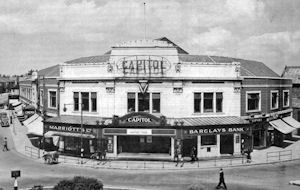 |
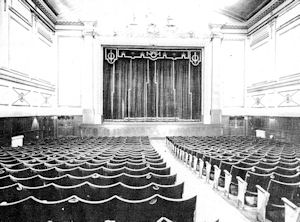 |
Prior to the building of the cinema the site was occupied by Gibson Corner which was a block of stable yards that stood on the corner of Seaview Road and Liscard Village. The site was cleared and the owners, Messrs Bros. of Wallasey, built the new cinema which comprised of a cafe with a provision for dancing, fifteen lockup shops and office accommodation, in addition to the picture house. The Capitol opened on Saturday, 4th September 1926 with 'Midnight Sun' staring Laura La Plante (1904-1996) and Pat O'Malley (1890-1966). The cinema was able to seat 1,390 patrons and had a large balcony with a tiered form of seating. A full orchestra under the direction of a local musicians provided musical entertainment. Proceeds from the performance on the opening night was donated to the Victoria Central Hospital which amounted to £22.9s.9d. The first manager of the Capitol was Percy Inkester and prices for seating were 6d, 8d, 1/- and 1s 2d.
The front of the building was finished in glazed terracotta with a large verandah which protected those queuing outside from the rain. A large waiting room was situated in the foyer as well as a central box office and a terrazzo floor. The auditorium was very lofty with four ornamental grilles in the ceiling which concealed air ducts equipped with high powered electric fans which provided ventilation. Suspended from the ceiling were six large Electroliers that provided illumination which was supplemented by glass flambeaux fittings on the side walls. Mahogany panels encircled the lower walls at ground level and were decorated above in shades of cream and brown. To add comfort for the feet seats were arranged on stepped floors in both the stalls and the balcony.
The proscenium was framed in intricate fibrous plaster work and was surmounted by a prominent feature depicting three galleons in full sail. Deep purple crimson velvet curtains edged in gold with matching palmet finished the whole set off. From within the projection room, both these, and the screen curtains, were hand controlled.
The early years of the Capitol was beseeched with sound issues. The lofty auditorium caused poor acoustics, especially with the early years of 'talkies'. One measure taken to improve sound quality was a series of steel wires stretched at intervals across the auditorium at cornice level designed to deflect the sound downwards. It was not until the Capitol was taken over in later years by the Associated British Cinema that the problem was however resolved by the installation of new sound equipment first in May 1936 and, again, in July 1940, when Western Electronic Microphonic Sound was fitted.
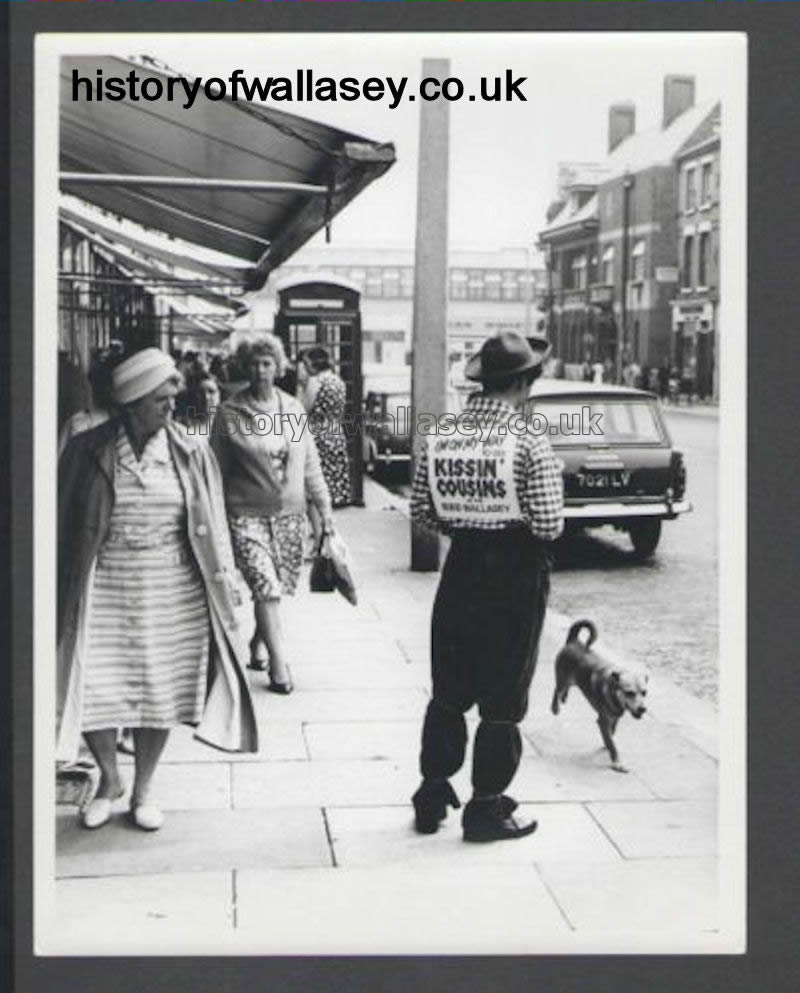 Further changes did not occur at the Capitol until February 1955 when CinemaScope was installed. In September 1959 the Capitol closed to undergo a complete modernisation programme - reopening two months later as ABC Cinema on Monday, 9th November 1959. Changes were made to the exterior of the building with the glass verandah being removed and a modern internally-lit advertising screen instaled. It was inside the Cinema that many of the new changes took place. Large sections of the old fibrous plasterwork from the walls was removed and a new giant screen was installed that covered the original proscenium, with wall-to-wall curtaining which was illuminated by floods situated at the front of the circle. The seats were made more roomy by removing some of them and a new-pay-box was installed in the foyer. Despite all the new changes the ABC Cinema struggled to recover its popularity. Many of the patrons deciding to find alternative form of entertainment and by early 1970's the Capitol closed its doors, showing Cliff Richard's 'Take Me High' as the last feature, on 23rd February 1974.
Further changes did not occur at the Capitol until February 1955 when CinemaScope was installed. In September 1959 the Capitol closed to undergo a complete modernisation programme - reopening two months later as ABC Cinema on Monday, 9th November 1959. Changes were made to the exterior of the building with the glass verandah being removed and a modern internally-lit advertising screen instaled. It was inside the Cinema that many of the new changes took place. Large sections of the old fibrous plasterwork from the walls was removed and a new giant screen was installed that covered the original proscenium, with wall-to-wall curtaining which was illuminated by floods situated at the front of the circle. The seats were made more roomy by removing some of them and a new-pay-box was installed in the foyer. Despite all the new changes the ABC Cinema struggled to recover its popularity. Many of the patrons deciding to find alternative form of entertainment and by early 1970's the Capitol closed its doors, showing Cliff Richard's 'Take Me High' as the last feature, on 23rd February 1974.
The building was not used again until converted for bingo as well as a social club in 1978. It remained so until the early 1990s when it again closed. Currently this once fine building lies derelict with much demolition work already been carried out inside. New shops units are planned.
The Liscard Electric Palace, a purposed built cinema, opened on 25th November, 1911 in Seaview Road in the centre of the town.
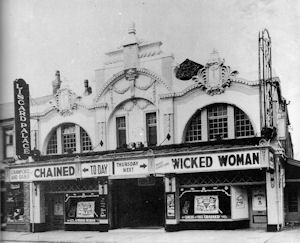 The entrance to the cinema had two shops on either side and surmounted by a large-glass canopy below an elaborate and dazzling white, fibrous plaster-covered facade that included three arched window features and at night was illuminated by hundreds of lights. The entrance hall was spacious and handsomely decorated with its marble floor which was relieved with delightfully coloured windows. On the on the right hand side of the vestibule was the main pay box and a feature of the entrance hall was the centrally located kiosk from which refreshments could be purchased. Two broad luxuriously carpeted staircases led to the small 180 seater grand circle. The golden panelling of the walls artistically harmonised with the coloured lights. No artifical lighting was required during the day as there was windows near the top of the building.
The entrance to the cinema had two shops on either side and surmounted by a large-glass canopy below an elaborate and dazzling white, fibrous plaster-covered facade that included three arched window features and at night was illuminated by hundreds of lights. The entrance hall was spacious and handsomely decorated with its marble floor which was relieved with delightfully coloured windows. On the on the right hand side of the vestibule was the main pay box and a feature of the entrance hall was the centrally located kiosk from which refreshments could be purchased. Two broad luxuriously carpeted staircases led to the small 180 seater grand circle. The golden panelling of the walls artistically harmonised with the coloured lights. No artifical lighting was required during the day as there was windows near the top of the building.
Though the auditorium was narrow it could however hold a total audience of 700 and curtains enclosing the entrance doors eliminated most of the draughts on the ground floor. Both the screen and the stage were tastefully encased in moulded design whilst the side walls between the pilasters were adorned with a series of panels framed in heavy plaster mouldings. The pilasters themselves were decorated with medallions in bas-relief. Further elaborate touches were provided in the auditorium by the deep dado with heavy moulded capping and an attractive colour scheme in which yellow predominated and which was finished with pairs of warm red coloured flambeaux wall lights on the pilasters. The majority of ground floor exits opened on to a passage at the right hand side of the building that was also used as a separate entrance to the front of the stalls area.
The opening films were 'Mount Etna In Eruption', an early French documentary, 'A Gay Time In Washington', a comedy starring Jack Hopkins, 'The Circular Fence' starring J. Warren Kerrigan, 'Italian Blood' with Charles West, 'Parson and the Bully' a western with Harry Tenbrook, 'There's A Woman In Town', a comedy starring Octavia Handworth, 'The Three Brothers' with Donald Hall and ''Beware of the Dog'. The programme was billed as 'World in Action Animated Photograph: interspersed with vocal items'. Evening performances were continuous from 6.30 to 10.30 pm and there were matinees daily at 3.00 pm at which afternoon tea was served free. Prices were Pit stalls 3d, Stalls 6d and Grand Balcony 1/-. The manager at the time was Reginald F.Astley who was later succeeded by Claude Adams who remained in charge for many years.
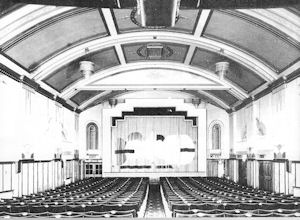 There were several important milestones in the history of the cinema after its initial opening that may be worthy of note. In 1920 the screen end of the premises was extended and the seating capacity increased to just under a thousand. Two years later the two shops were incorporated into the cinema to provide waiting room accommodation. In January 1923 'The Glorious Adventure', an early silent film starring Victor McLaglen who went on to Hollywood to star in John Ford films, advertised as the first colour picture to be made in England, was shown. It was produced in 'Natural Colour' which was said to be "rather too sharply defined at times rather gaudy". In 1928, as part of a redecoration scheme, the panels on the side walls were painted with attractive murals depicting Venetian and Swiss scenes, whilst at the screen end of the hall bottle-green velour curtains trimmed with gold were put up together with 'swags' in matching material. On 4th August 1930 when B.T.H. sound had been installed Marion Davies featured in her "talking and singing triumph", 'Marianne', the first sound picture to be shown at the Palace. In 1931, the Universal British Talking News with commentary by R.E. Jeffrey, the world-famous BBC commentator, was a popular addition to every programme.
There were several important milestones in the history of the cinema after its initial opening that may be worthy of note. In 1920 the screen end of the premises was extended and the seating capacity increased to just under a thousand. Two years later the two shops were incorporated into the cinema to provide waiting room accommodation. In January 1923 'The Glorious Adventure', an early silent film starring Victor McLaglen who went on to Hollywood to star in John Ford films, advertised as the first colour picture to be made in England, was shown. It was produced in 'Natural Colour' which was said to be "rather too sharply defined at times rather gaudy". In 1928, as part of a redecoration scheme, the panels on the side walls were painted with attractive murals depicting Venetian and Swiss scenes, whilst at the screen end of the hall bottle-green velour curtains trimmed with gold were put up together with 'swags' in matching material. On 4th August 1930 when B.T.H. sound had been installed Marion Davies featured in her "talking and singing triumph", 'Marianne', the first sound picture to be shown at the Palace. In 1931, the Universal British Talking News with commentary by R.E. Jeffrey, the world-famous BBC commentator, was a popular addition to every programme.
Liscard Palace announced on 15th June, 1935 that it would close for a week for modernisation and decoration. During the week closure the auditorium was transformed by the removal of the old fibrous plaster from the side walls and the latest form of modernistic decoration was applied using echo resisting plastic paint. Different shades of rich colours were applied including greens, creams, pinks, Venetian reds and silver. The ceiling panels were painted in varying shades of blue, the darkest shades being adjacent to the screen. At either side of the new proscenium were ornate ventilation grilles and the theatre was reseated throughout. Also an improved sound system was added as well as a new projection. The screen end of the Palace was transformed where a new, shallow, stage platform had been constructed and fitted out with two sets of curtains. The main drapery, which was operated by a hand winch in the projection room, was in gold appliqued with a bold pattern in brilliant coloured silks. The electrically operated screen curtains were adorned in silver satin with a trio of panels per curtain. The curtains were illuminated with a Holophane auto-cycle colour lighting that illuminated these curtains in ever-changing varieties of colour through the medium of footlights.
At the beginning of the 1950's the facade of the cinema was replaced with a new rustic brick version, and in 1955 a new 30ft wide CinemaScope screen was placed forward of the original proscenium and an upward-rising festoon curtain was installed. During the 1950's, as with many cinema's in the area, Liscard Palace began to see a decline in box-office taking which resulted in its closure. On 3rd June 1959 the last two films shown at the Palace was 'Love Slaves Of The Amazon' staring Don Taylor (1920-1998) plus 'Hold Back Tomorrow' with Cleo Moore (1924-1973) and John Agar (1921-2002). The year would also see the closure of the Embassy and the Winter Gardens.
Later the building was converted into a Lennon's Supermarket and today it is the Shoemarket.
Wallasey Village |
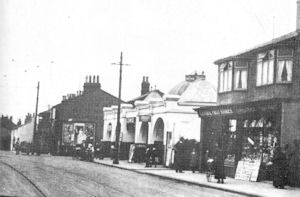 The 'Cosy Cosmo' opened on the 12th May, 1913 in Wallasey Village and was advertised as hygienic and comfortable with a superb programme of animated pictures, the first of which was 'For The Honour of the 7th' and starred Harold Lockwood (1887-1918) and Ann Little (1891-1984), who was the early cartoon voice of 'Betty Boop'. Music was described as the 'unrivaled Cosmo orchestra' under the late leader of the H.M Grenadier Guards, Ernest Rumbold. The cinema was able to seat 700 people on one floor and programmes were continuous from 3.00 to 10.30 pm at prices of 3d, 6d and 1/-.
The 'Cosy Cosmo' opened on the 12th May, 1913 in Wallasey Village and was advertised as hygienic and comfortable with a superb programme of animated pictures, the first of which was 'For The Honour of the 7th' and starred Harold Lockwood (1887-1918) and Ann Little (1891-1984), who was the early cartoon voice of 'Betty Boop'. Music was described as the 'unrivaled Cosmo orchestra' under the late leader of the H.M Grenadier Guards, Ernest Rumbold. The cinema was able to seat 700 people on one floor and programmes were continuous from 3.00 to 10.30 pm at prices of 3d, 6d and 1/-.
The frontage of the Cosmo included 4 shops and was surmounted by a central glass dome with a spiral staircase behind leading to the where the projection room was located. Behind one of the shops was housed the electric generator that was located in a shed which supplied direct current for the projector arcs. The theatre lighting though was taken from the town supply. The entrance to the cinema was through an elegant red-carpeted octagonal foyer decorated with potted plants.
Throughout it's short history (only existing for 28 years) the theatre underwent a number of changes in ownership, management and entertainment policy. From the winter of 1917 onwards the cinema was advertised as 'The Cosy Cosmo'. The lessee at this time being Frank Watson. Control of the Cosmo was under F.V Ross by 1924 who was already well known in Wallasey for his association with the Hippodrome and Tivoli Theatres.
On Monday, 24th June, 1924 the Cosmo was re-opened as the Coliseum after the addition of a 40 foot deep stage with fly tower and nine-dressing rooms. The general decorative scheme was in Prussian blue, white and gold. The carpet and seat upholstery were in rich blue velvet pile and curtains of the same colour edged in gold. The ceiling was white and the walls finished in yellow tone. G.W.E Campion was the manager and the opening programme was Charles Wades's 'Concord' Company, described as a Super Concert Party. Prices were 9d, 1/3 and 1/10 with performances once nightly except on Saturdays which two performances were staged.
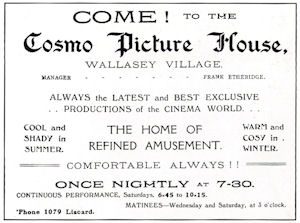 By Easter 1925 there was a reversal to films as the staged entertainment was not a success. there was also a change in management and the theatre was re-named as 'The Wallasey Picture House'. The first film programme shown was 'The Family Secret' starring the child star Baby Peggy (1918- ) and Gladys Hulette (1896-1991), and the Apollo Orchestra was under the personal direction of Fred Halliday. From September 1925, Mabel Stocks and her Wonderful Orchestra were advertised, and by February 1927 there was a reversion to the name of Coliseum, although pictures continued to be the main fare offered. The manager at this time was S.A Jones and 500 tip-up seats were advertised at 8d. In September 1929 a 'Band Box Review' was advertised on stage together with the full film programmes were advertised. The week of 20th January, 1930 saw a brief reversion to purely stage entertainment starting with a review called 'All The Best', featuring twelve beautiful scenes, admirably staged with the Desmond Girls and Mlle. Veronica from the Winter Gardens in Berlin. Programmes were twice nightly at 6.30 and 8.40 pm.
By Easter 1925 there was a reversal to films as the staged entertainment was not a success. there was also a change in management and the theatre was re-named as 'The Wallasey Picture House'. The first film programme shown was 'The Family Secret' starring the child star Baby Peggy (1918- ) and Gladys Hulette (1896-1991), and the Apollo Orchestra was under the personal direction of Fred Halliday. From September 1925, Mabel Stocks and her Wonderful Orchestra were advertised, and by February 1927 there was a reversion to the name of Coliseum, although pictures continued to be the main fare offered. The manager at this time was S.A Jones and 500 tip-up seats were advertised at 8d. In September 1929 a 'Band Box Review' was advertised on stage together with the full film programmes were advertised. The week of 20th January, 1930 saw a brief reversion to purely stage entertainment starting with a review called 'All The Best', featuring twelve beautiful scenes, admirably staged with the Desmond Girls and Mlle. Veronica from the Winter Gardens in Berlin. Programmes were twice nightly at 6.30 and 8.40 pm.
The Coliseum became Wallasey's latest Talking Theatre on 24th March, 1930. The opening attraction was Harry Beaumont's 'Broadway Melody' starring Bessie Love (1898-1986) and Anita Page (1910-2008). In 1931 the Coliseum was yet again under management with the latest British Thompson Houston (B.T.H) Talkie Installation, new projectors and a new screen. The following year a scheme was announced for 'important re-construction' by one of the syndicates to provide a capacity of 1,500 with a balcony holding 350, but the plans never went ahead.
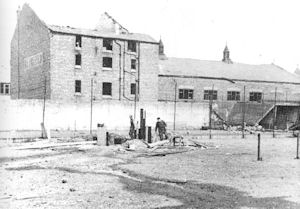 |
During the 1930s a popular feature at the Coliseum was Saturday afternoon children's matinees were all seats cost 2d. No further changes occurred at the Coliseum until the war came in 1939 when, keeping in common with all places of entertainment, the cinema closed on the outbreak of hostilities but re-opened just two weeks later. In January 1940 Mr C.W Binks organised concerts on stage every Sunday. However German air raids caused cinemas to curtail their evening performances which now started an hour earlier in order to finish at 9.30 pm. Due to falling numbers in attendances because of the air-raids the Cinema announced a temporary closure from the 9th November 1940. The last film being shown was the British comedy 'Middle Watch' starring Jack Buchanan (1891-1957) and Kay Walsh (1911-2005) who was to later star in the 1950 film 'The Magnet' which was filmed in Wallasey. In March 1941 a direct hit by a German bomb caused extensive damage that led to the demolition of the Coliseum soon afterwards.
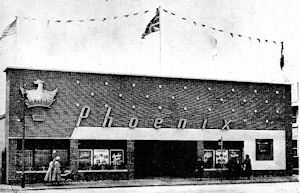 |
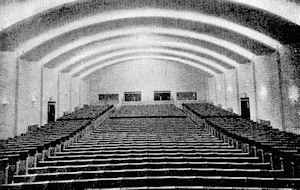 |
The Phoenix cinema 'rose from the ashes' of the Coliseum and was opened on Monday, 4th June 1951 by the Mayor of Wallasey, Alderman G.H Young. The cost of the new cinema was £40,000 and was designed by the 24 year old Liverpool architect, Mr. Alexander Webb. The Phoenix was his first ever design and he went on to build the £100,000 Albany Cinema in Maugahll, Liverpool, in 1955, which closed in 1995 and the site is now a supermarket. The front exterior of the cinema was in plain slate and rustic brick and included a pink neon Phoenix. All the doors inside were made of mahogany and at the end of the 40 ft wide foyer was the manager's office and a small buffet. The woodwork in the buffet was in bird's eye maple, one of the rarest kinds of wood. The auditorium was plain in design with the expanse of side walls broken up by a series of plain plasters. Across the ceiling were six fibrous plaster trough sound-breakers stepped down towards the proscenium to conceal the house lighting which was supplemented by ceiling-mounted glass fittings adjacent to the small stage, itself equipped with two colour floodlights. The single storey auditorium seated 930 and was decorated in pale pink with the seating being in blue crushed velvet whilst the stage curtains were in dark blue with silver relief. All the soft furnishing had been personally chosen by the proprietor's wife.
The proprietor of the Phoenix, Mr. Leslie Blond, described it as "a cinema of tomorrow"; a bold statement backed with equipment, amenities and design some twenty years ahead of its time. It was claimed that the Phoenix was the first cinema in the UK with the latest Western Electric sound equipment which was not available to the rest of the country. At the rear of the auditorium were 'cry rooms'. These were two sound-proof rooms that were equipped with their own glass windows and loud speaker system which was linked to the main theatre sound system. This enabled mothers with small children to watch the film without disturbing the rest of the audiences with troublesome and noisy children. Later the rooms became part of the auditorium by the removal of the partition walls and windows, resulting in cosy alcoves at the rear.
The opening film shown at the Phoenix was John Wayne's and Maureen O'Hara western, 'Rio Grande', and admission was 1/3, 1/10, 2/4, and 2/10 for continuous performances between 5.30 pm each day (from 5.00 pm on Sundays), and children's' matinees at 2.00 pm on Saturdays.
In July 1953, The Phoenix became the first cinema in Wallasey to be fitted with a wide screen which was described as "twice bigger than normal wide screens". The Phoenix continued to be Wallasey's most popular cinema for many years and even when many other picture houses in the borough were closing it continued good business. By the mid 1970s. however, Leslie Blond sold his cinema to the Hutchinson Group who sub-divided the auditorium soon after and converted the premises into two small 250 seater cinemas and provided a new entrance to the front for bingo patrons. Just after a few years the bingo section was closed when the operation was not a success. Films, however, were continually profitable until the early 1980's. Even with reduced entrance fees of £1 for adults and 60p for children every night, closure was inevitable with audience numbers dwindling. Mr G.A Mander, manager of the Phoenix for 13 years, showed the last two films on the 6th July 1983; 'Tootsie' starring Dustin Hoffman in Cine 1 and 'An Officer and a Gentlemen' starring Richard Gere in Cine 2. The cinema lay vacant for some years and was demolished in 1988 and sheltered housing built on the site.
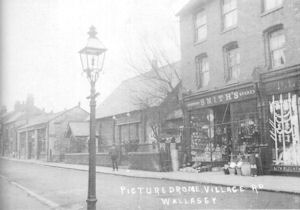 |
Originally the Wallasey Picturedome was a 200 seater Wesleyan Chapel that was built in 1885. By 1910 the congregation had moved to alternative premises in Claremount Road. The building was then converted into the Wallasey Picturedome and opened on 6th March 1911, under the management of Miss. M. Hardy, with piano accompaniments by Mr. Clutterbuck. The pianist was supplemented first by a singer, Miss. M. Solari and then by a comedian, Mr. Hal Rowe. Performances were advertised as 'popular pictures at popular prices' and they were scheduled at 6.30 pm and 8.30 pm daily as well as a Saturday matinee at 3.00 pm. Admission for the picture- house was 2d, 4d and 6d in the tip-up seats and a feature of the opening performances was 'The Love of a Chrysanthemum' which was described as a very artistic coloured production.
By the end of 1911 there was a change in management and on 11th December 1911 the cinema re-opened but two weeks later the Picturedome closed again for 'alterations and cleaning'. On Monday, 8th January 1912, the cinema re-opened with a star studded programme including a variety act known as The Two Kraks. By early 1912 the Wallasey Picturedome ceased operation and closed for the final time and the building was converted in to shops; still standing today as 131 - 137 Wallasey Village.
New Brighton |
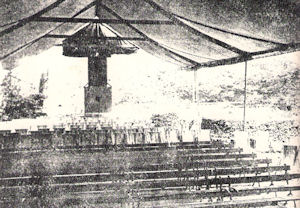 |
The Daylight Cinema opened on Saturday, 10th May, 1913 and stood adjacent to the Tower Grounds amusement complex. Leased by Pike and Alcock, it was Wallasey's most unusual cinema. A collection of deck chairs and benches provided seating for several hundred people under an awning in a sheltered position of Quarry Gardens by the promenade. The screen was positioned on a platform that was also used by variety artistes who performed to fill in gaps as film reels were being changed. Housed in a wooden tower-like structure that stood behind the audience was the projectionist and his equipment. This was the first location in this part of the UK to offer such entertainment.
The cinema advertised "first class pictures and variety entertainment twice daily at 3.00 and 8.00" and prices varied from 3d, 6d and 1s. It was claimed that the pictures were produced using a novel process to enable them to be distinct when projected onto the screen in daylight but despite this claim for bright and clear pictures the same could not be guaranteed for the New Brighton weather which, no doubt, was in part the main reason for the early demise of this venture at the end of the following July.
In 1881 a new amusement complex opened on the Promenade which housed a grand hall, a small concert hall, skating rink aquarium and aviary. The main entrance was in Virginia Road with additional access from the Promenade. In 1893 the theatre became known as 'The Palace and Pavilion Theatre' and in 1895 it came under the control of the New Brighton Palace Company Ltd., with Mr. M.D. Ellery as Managing Director.
The fortunes of the enterprise changed with the arrival of the Tower and the Palace began to decline. Plans were developed to revitalise the Palace which involved a Manchester concern which proposed erecting the biggest revolving wheel the world had ever seen with forty-two carriages each holding forty passengers. However, the project was abandoned.
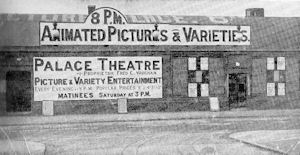 In 1906 the Palace exploited the new influence of animated pictures and thus becoming the second in Wallasey to be used as a cinema. The premises then became controlled by Wallasey Corporation, with Messrs. Lievers and Bennet the new leases and Mr. Percy Penny the new manager. Northern Cinematograph Trading Company provided motion pictures in the mixed programme.
In 1906 the Palace exploited the new influence of animated pictures and thus becoming the second in Wallasey to be used as a cinema. The premises then became controlled by Wallasey Corporation, with Messrs. Lievers and Bennet the new leases and Mr. Percy Penny the new manager. Northern Cinematograph Trading Company provided motion pictures in the mixed programme.
The opening first film programme comprised:
The Great Thaw Trial - the topic of the day; hundreds of side splitting comic pictures My Word, if you 're not off - the popular saying illustrated; The Limerick Craze - showing how Jones did not win £5,000; The Model Husband - a real side splitter; no wife should be without him; The Gamekeepers Dog - man's faithful friend in time of trouble; and The Hits of the Season - shots of His Majesty King Edward VII and all the Royal family aboard the battleship Dreadnought. Other early films included The Fisher Girls Wooing. Satan at Play and The Mill Girl (a touching tale of factory life). The films were considered to be of good technical quality and of such a moral and refined nature that ladies, gentlemen and children would find them pleasing. Performances were each evening at 8.00 pm with a Grand Illuminated Childrens' Matinee on Saturday afternoons at 3.00 pm. Admission cost between 2d and 1/6 for the evening house and 2d and 3d for the childrens' afternoon sessions.
Inside the Palace was however, was spartan, with its poor heating, corrugated iron roof and uncomfortable wooden bench on a flat ground floor. Originally there was seating for 750 which was later expanded by the addition of a balcony. Entering the cinema was by a small square vestibule that was on a level with the balcony and also which contained the paybox. On the right hand side of the vestibule was the staircase which led to the ground floor. The walls of the auditorium were plain with a deep painted dado and a high stage. The main decorative scheme was in off-white and crimson with two plaster statues of Greek goddesses in arched alcoves at either side of the stage. The stage used back cloth rollers instead of a fly tower.
In 1910 live shows became the main feature which was continued when Mr. F.Vaughan became manager. The Tivoli Company Ltd took control for awhile but when problems occurred with the building of the Tivoli the lease was then sold to Mr. Ludwig Blattner who was formerly with the Irving Theatre in Seacombe. To compete with the other more modern cinemas in the area the theatre underwent a new image and, after a short closure, was reopened as the 'Gaiety', on Easter Monday 1914. Modifications included an increased seating capacity to 1200 and the establishment of the Royal Bohemian Orchestra with Herr Heinrich Fieler and his violin.
Blattner's reign came to an abrupt end with the outbreak of the First World War in August 1914 and he was forced to take up >>>
residence in an internment camp for the duration. After the war Blattner was to become a film producer in London and also became well known as the inventor of a magnetic wire recorder known as the Blattnerphone. He died on October 1935 after committing suicide due to a failing business.
By October 1914, the "worked by an all-British staff" Gaiety was managed by Alfred Delmonte who later became the musical director at the Marina. He advertised the Gaiety with "numerous improvements -- including modern heating apparatus installed throughout the building" and claimed to be "the cosiest entertainment in the district". In December 1914 there was another change in administration and "beautiful pictures in conjunction with high-class orchestral music" were advertised with "Go-as-you-please" contests every Friday, the profits from the first week being donated to the Wallasey War Relief Fund.
Wounded soldiers from the front line attended Wednesday afternoon concerts at the Gaiety which became a regular feature as the war progressed. Artistes would give their time free of charge. The theatre was open for film performances for a period during the winter season but only on Wednesdays and Saturdays.
A major fire swept through the complex on 22nd April, 1916 which destroyed the skating rink and other parts of the building, but the theatre itself was saved as a result of the strenuous efforts of the firemen. For a time the theatre was known as 'Palace Picture Playhouse'. In 1920 the lease was taken over by Pat Collins Jnr who was a well-known fairground operator and the theatre then became known as 'Collins' Palace Cinema'. The main entertainment were films. but for a short period in 1923 there was a reversion to purely live shows when "the highest-class concert parties in the country" were advertised. The theatre closed throughout 1924-1925 and reopened on Whit Monday 1926 and advertised as redecorated and re-seated with prices ranging from 3d to 1/3. Joseph W.Gabriel was the lessee who was a well-known local pianist and conductor. Reginald Eysenck was the manager who was formerly of the Lyceum Picture House in Eastbourne.
Performances at the theatre included daily matinees at 2.30 pm and evening shows continuous from 6.15 pm to 10.15 pm. 'The Sky Raider' was the opening programme featuring Charles Nungesser (1892-1927) and Gladys Walton (1903-1993) with a Larry Semon Comedy. 'Frauds and Frenzies', 'Pathe Pictorial' and 'Pathe Gazette'. plus a musical interlude by Joseph Gabriel and his orchestra.
On 11th December, 1926, the Palace finally closed, with a showing of 'Spook Ranch' featuring Hoot Gibson (1892-1962). Plans to develop the site were suggested in 1932 and after standing derelict for several years, the Palace was eventually demolished in 1933 to make way for the construction of The New Palace Amusement Park.
In November 1912, Mr H. Phillips applied for permission to use the ground floor at Egerton Hall, a small public hall on the corner of Egerton Street and Mason Street, New Brighton, for exhibiting animated pictures.
Entrance to the hall was by double doors at the corner of the two storey building in Mason Street which opened into a small vestibule and at the top of a short flight of steps was the paybox, to the right which was the entrance into the flat-floored auditorium with seating for 200. The exit doors opened out on the right hand side of the hall into Mason Street and the small projection room was adjacent to the pay-box.
The facilities provided were extremely basic, and opening and closing dates are not known, but, it appears that the hall was only used for less than a year for showing films, after which time it reverted to its former use.
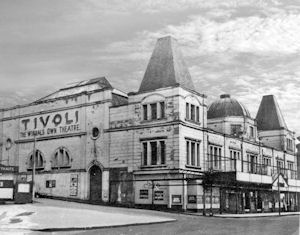 |
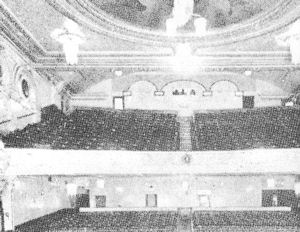 |
On 6th, April 1914 The Tivoli theatre opened with Lilly Langtry (1853-1929) topping the bill. The Tivoli was situated on the promenade close to the New Brighton pier with a frontage that included six shops and cafe, which extended along the whole width of the building. The theatre could seat 636 people and had an ornate auditorium with a balcony that curved round almost to the boxes at either side of the stage. The stage was well equipped and included an excellent walkway above the stage called a fly tower.
The Tivoli was originally under the management of Mr. F.V.Ross, but in September 1921 Pat Collins bought the theatre for £37,500 which was eventually sold at a loss in October 1928 for £27,000 to Provincial Cinematograph Theatres. The theatre was rarely used as a cinema throughout its history, even though an edition of the Pathe Gazette newsreel was shown to complete most variety bills prior to the introduction of the talkies. The main reason why the Tivoli never showed reels between its opening and 1923 was because the theatre was the greatest Vaudeville success on Merseyside as indicated by the subsequent acquisition of the Kings Theatre, Seacombe, for £8,000 from the profits from the Tivoli.
On Monday, 19th February 1923 the Theatre reopened as the Tivoli Super Cinema with 'Saturday Night', a Cecil B. DeMille Paramount Super Play Cell production, starring Leatrice Joy (1893-1985) and Conrad Nagel (1897-1970), supported by 'A Sporting Double' and the super serial 'Across Two Continents'. There was a "special musical setting" played by the Piccadilly Orchestra and there were also "magnificent colour schemes" and "clear pictures" advertised. Prices of admission being 4d, 6d and 1/-. However, from 2nd April 1923 there was a reversion to stage revenues and F.V. Ross was again managing the theatre at the end of 1925.
In October 1928 the theatre announced that the new owners would in future present the latest pictures. The first film presentation was on Monday, 8th October with 'Ramona' staring Mexico's fist international female star, Dolores del Rio (1904-1983), plus 'Woman's Wares', and non-stop programmes were advertised from 2.30 to 10.30 pm with prices from 6d to 1/3d. The musical interludes were provided by the Tivoli Orchestra under the direction of Richard Tomlinson. Up until 6th, April 1929 films continued to alternate with stage programmes but after a period of closure, the Tivoli returned again to mainly stage entertainment from 1st, July 1929.
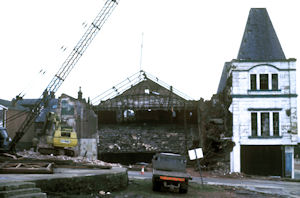 In June 1930 the Tivoli showed the last film season when a Grand re-opening with 'Talkies in the Tivoli' was announced with Western Electric Sound System installed. The film shown was 'Flight' with Jack Holt (1888-1951) and Lila Lee (1901-1973). Prices for seating were 1/3 for the circle, 9d for stalls, 6d for the pit and matinees were at 2.30 pm and evening continuous from 6.15 pm. However, on 14th July, it was announced that the variety season would open so films were never to be seen again at the Tivoli.
In June 1930 the Tivoli showed the last film season when a Grand re-opening with 'Talkies in the Tivoli' was announced with Western Electric Sound System installed. The film shown was 'Flight' with Jack Holt (1888-1951) and Lila Lee (1901-1973). Prices for seating were 1/3 for the circle, 9d for stalls, 6d for the pit and matinees were at 2.30 pm and evening continuous from 6.15 pm. However, on 14th July, it was announced that the variety season would open so films were never to be seen again at the Tivoli.
The theatre went through further management changes and several closures and by 1937 was renamed as 'New Tivoli' but the title was soon dropped. Between 1939 and 1940 the theatre remained closed and was then re-opened but only to close again a few months later as a result of war damage. It was not until 1945 that the Tivoli was re-opened as primarily a theatre by Leam Production Ltd. However, by the 1950s efforts to try and save the Tivoli from closure were to no avail and its end as a theatre finally came in April 1955. The stalls area in the theatre were used for a short time as an amusement arcade but after a serious fire the building was finally demolished in 1976.
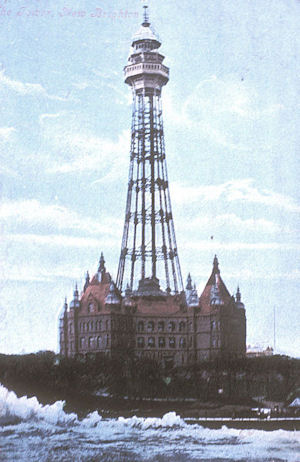 |
The Tower was built on the river front in New Brighton overlooking the Mersey between 1896 and 1897 as an entertainment complex. The extensive grounds housed gardens, a fairground and zoo. The main huge building carried a 500ft high tower, and, with a total height of 620 ft above se level, was described as 'the highest structure in the United Kingdom' - even higher then the Blackpool Tower at 520 ft. There were four lifts, and trips to the top pf the tower cost 6d. The building itself comprised a ballroom below which was a theatre with a seating capacity in excess of 3,000 proving to be the largest in the Provinces. The depth of stage, which was claimed to be the largest in the world, amounted to 72 ft and the proscenium was 45 ft wide. The auditorium was of a amphitheatre design.
The theatre was used for a range of entertainment purposes over the years, mainly on a seasonal basis, but at the forefront was always musical reviews and orchestral concerts. In fact Edward Elgar appeared in person at the Tower on 16th, July 1899. The latest Animated Pictures by the Royal Bioscope were being advertised as early as 1904 which included shots of the Russo-Japanese War. In 1907, stage shows were accompanied by 'The Truly Wonderful Chronophone Talking. Singing and Dancing Pictures'.
Unfortunately the elements took its toll on the steel tower which deteriorated so badly as a result of the lack of maintenance, that it had to be demolished over a 2 year period between 1918 - 1920. It did not, however, affect the remainder of the complex which continued to function as normal.
The theatre continued to swing back and forth between live entertainment and films. In 1925 Gracie Fields appeared at the Tower Theatre in 'By Request', a review written and produced by Archie Pitt. In 1926 'Variety Artists and Pictures' were advertising nightly, whilst two stage attractions for Easter 1927 were Jack Hylton's Famous Band on Good Friday, and Dame Clara Butt and Party on Easter Sunday. These were complemented by cinema performances from 3.00 to 10.30 pm, except on Good Friday.
In the 1920's, for a period, the theatre stage was used to accommodate two badminton courts. . Films were projected onto the safety curtain at the front of the stage, thus leaving the stage itself free for badminton players. From 1928 films were no longer on the programme and its main use was to stage wrestling matches and occasional concerts.
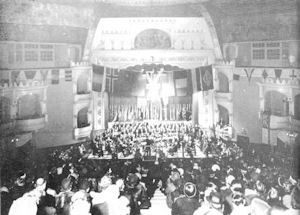 |
By May 1954 a revival occurred when the Tower showed a summer season of comedy films and a puppet theatre which was shown on Saturdays and Sundays continuously between 2,00 and 6.00 pm, at a cost of 6d. This continued up to August and thereafter films were no longer shown.
The condition of the Tower Theatre deteriorated rapidly after a period of disuse and on 5th April 1969 a spectacular fire destroyed the building and the charred remains had to be demolished.
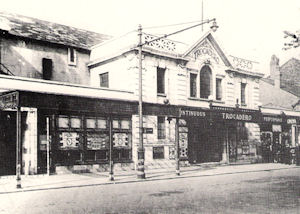 |
In 1919 a company was formed which acquired a block of shops as well as the Albert Billiard Hall in Victoria Road with the aim of converting the premises into a picture house. Mr. George Temperley was the managing director who had previously been the manager of the Liscard Palace in Seaview Road. The architects for the new building were Messrs. Wright and Hamlyn of Warrington and even though their was initial problems in gaining access to the billiard hall as well as a court battle to evict the original owners, the project was completed by the builders Messr. George Snape and Son of Birkenhead in 1922.
The Trocadero was built from reinforced concrete and was of fire-proof construction. The main frontage was executed in cream tinted terra cotta and the central portion, which rose above the entrance, was finished with a heavy pedimented gable and well proportioned windows. Either side were lock-up shops surmounted by a plain parapet. Throughout the length of the frontage in Victoria Road, was a wrought-iron and glass verandah to provide shelter in bad weather for patrons queuing outside.
The cinema was capable of accommodating some 900 people inside in what was considered at that time, to be the most luxurious surroundings. The main entrance to the cinema had marble paving which provided access through mahogany swing doors that lead into a spacious hall panelled in keeping with the entrance doors. Leading directly from the hall were the entrance doors to the auditorium and immediately to the left was an elaborate staircase, with its massive balustrade. The stairs led to the foyer on the first floor, which in turn gave access to the luxurious balcony which had been constructed on a slope so as to ensure every seat had a clear view of the screen.
The inside walls were of simple and restrained style. The main piers were run up as plasterers finished with enriched brackets from which sprung arched ribs of decorative plasterwork across the ceiling. The intervening wall spaces between the plasterers were richly panelled in modelled plaster work leading up to an effective treatment over the circular windows, and surmounted at the eaves by a well-proportioned classic cornice. The infilling to the ceiling was also effectively broken up by a series of panels and enriched ventilating gratings. The proscenium front and arch was boldly treated forming a fitting frame to the silver screen and its drapers. The tip-up seats were upholstered in blue corduroy velveteen and finished with mahogany backs and arms. Heating the cinema was provided by a low-pressure hot water system, whilst the air conditioning comprised a blower fan to provide fresh, warm air at a low level to eliminate floor draughts.
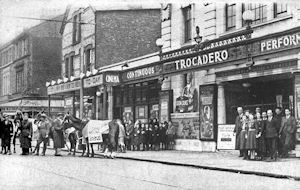 The Trocadero was formally opened on 1st June, 1922 by the Mayor of Wallasey, Alderman Augustine Quinn. The first film shown was 'Perjury', staring William Farnum (1876-1953). A selection of comedies followed the film as well as news items and educational topics. Music was provided by the Tracadero Symphony Orchestra under the baton of Mr. Bescoby. The acting manager was Mr. C.H. Hankinson, who had previous experience with the Hippodrome and the Tivoli Theatre. The cost of admission were 6d, 9d and 1/3.
The Trocadero was formally opened on 1st June, 1922 by the Mayor of Wallasey, Alderman Augustine Quinn. The first film shown was 'Perjury', staring William Farnum (1876-1953). A selection of comedies followed the film as well as news items and educational topics. Music was provided by the Tracadero Symphony Orchestra under the baton of Mr. Bescoby. The acting manager was Mr. C.H. Hankinson, who had previous experience with the Hippodrome and the Tivoli Theatre. The cost of admission were 6d, 9d and 1/3.
Even though the construction of the Trocadero had been financed by local businessmen, the cinema soon after opening changed hands to the Liverpool based First Federated Cinemas (J.F. Wood circuit). In 1928 it then became part of the rapidly expanding Gaumont-British circuit under whose control it remained until closure, the manager for many years being Robin Jones. The first talkie film to be shown was 'The Great Gabbo' with Erich von Stroheim (1885–1957) on Monday, 24th March, 1930.
The circle was reconstructed, re-seated and redecorated in November 1936 and the old alabaster light fittings being replaced by V-shaped metal framed pendant fittings, with amber tinted glass. The glass was removed from these fittings when war broke out in September 1939 to prevent the possibility of it being showered onto the audiences during the course of an air-raid. The fittings themselves were removed later on and replaced by a single large amber-coloured lamp in each instance.
The height of the screen at the cinema was a problem for front seat occupants because it was positioned on a very shallow stage platform, resulting in the first front rows having a distorted view of the image on the screen. In May 1944 CinemaScope was installed which gave a picture slightly wider than the original screen, but on 22nd September 1956, the Trocadero was closed with only a few days' warning. The cinema was converted into a supermarket for a time before being demolished.
Situated at 96/98 Victoria Road was New Brighton's first purpose-built cinema - Court Cinema. Opened on 6th December 1912, and compared to the standards of most cinemas, was a small, somewhat intimate theatre. It was described as "New Brighton's Cosy Picture Boudoir" with its best cinematic equipment and adequate ventilation to keep the air fresh and cool without creating draught. The internal decor was red and white with carpets, upholstery and light fittings setting the tone. The manager of the Court Cinema was Mr. Douglas Stuart.
The opening films, which included 'The Little Bear', 'Hydrogen', 'Henry VIII' and 'Romance at the Coat' were shown continuously from 7pm, with matinees on Mondays, Wednesday and Saturdays with admission at 3d, 5d and 1/-.
On Monday, 13th August 1931, "Perfect Talkies" was advertised , commencing with 'Near Rainbow's End' staring Bob Steele (1907-1988) and Louise Lorraine (1904-1981), and 'Borrowed Wives' with Rex Lease (1903-1966). Over the next couple of decades the cinema went through several changes in management, and in August 1940 when Mr. W.J. Speakman took control, much-needed new talkie apparatus was installed and some refurbishment took place. The Court re-opened in December 1943 and specialised as a New Theatre under the management of Charles Massey who had formerly managed the nearby Winter Gardens in Atherton Street. Two weeks later normal programmes of features films were re-instated as the venture was short lived.
After the Second World War the theatre was purchased by Whilma Wilkie, proprietor of the New Palace Amusement Park, who made major modifications both internally and externally to the building. New Kalee projectors were on exhibition between 29th November and 4th December 1947 to the public in a nearby shop which was specially rented for the purpose. This equipment was in use from 8th December in the completely re-modelled and re-seated auditorium. For the first time as well, electrically-operated curtains were in use. A new canopy was provided for the exterior of the building.
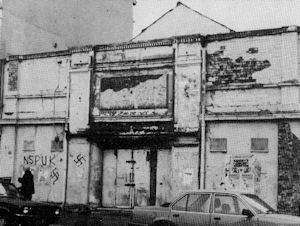 |
It was not until 1955 that further changes took place with the installation of a wall-to-wall CinemaScope screen. This meant that seating accommodation had been reduced from 450 to 384. Due to lack of support and rising overheads the closure of the cinema in October 1958 was inevitable. The following year the Court re-opened in July with the emphasis on comedy films. The Court continued in business for another ten years before finally closing in March 1969 with William Holden's 'The Devil's Brigade'. In July 1988 Wirral magistrates made an order against George Wilkie and Co. ltd that the damp ridden building, which had been stripped of its interior and was just an empty shell, either be made safe or demolished within twenty-eight days. Soon afterwards the building was demolished.
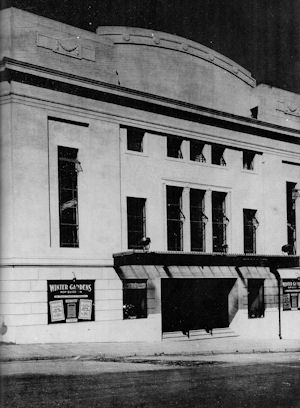 |
In 1907 Messrs A. Douglas and H.E Jones leased the old Conservative Club in Atherton Street for Saturday evening concerts. In February 1908 the Alexandra Hall was renamed as the Winter Gardens with programmes of plays and films, complete with an orchestra and palms. However, due to cramped conditions both on stage and in the dressing rooms, it was decided to rebuild the Winter Gardens and in 1910 the old auditorium was removed to be replaced by a grand circle. A 60 ft x 33 ft stage was provided as well as improved dressing rooms. Also installed, which was a wonder at the time, was electric lighting. The Winter Gardens remained opened throughout the First World War and in 1919, Mr Douglas became the sole owner.
In February, 1931 the directors decided to demolish the old Winter Gardens and build a new theatre in its place. Within four months the new theatre was rebuilt and opened on the 27th June, 1931. The new theatre was designed by Messrs T. Talisin Rees and R. Holt and had a striking facade with a canopy, displays boards, six entrances doors as well as floodlights for night time illuminations. The theatre could hold 1,400 seats.
The entrance foyer was large and housed the box office, two pay booths and a ladies' cloakroom; the gentlemen's cloak room was downstairs. On either side of the hall were stairs that led to a lounge with facilities for refreshments, including a bar. Above the mezzanine floor was a large balcony. An unusual feature of the balcony was the provision of two private boxes at either extremity of the circle front that curved outwards especially to accommodate them. Either side of the stage above each of the two exits there was an ornamental canopy supported by fibrous plaster columns. The main hall itself measured 87 ft 6 in x 57 ft 9 in. Beneath the balcony was a dome, illuminated by concealed lighting, whilst six groups of high-powered lights fitted with special reflectors in the ceiling void, provided the main illumination for the auditorium, the light passing through rectangular figured glass panels flush with the ceiling. The theatre boasted a large and well-equipped stage with fly-tower and generous dressing room facilities. The seats had arm rests and were of the tip-up variety.
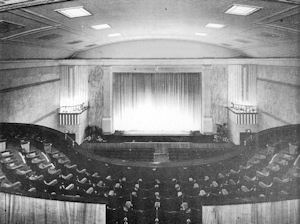 From the time the Winter Gardens opened it was clear that its destiny was uncertain. The building was designed primarily as a theatre but with a projection room built on as an insurance resulting in a constant shift between live performances and film shows. The first year of opening was promising for the theatre but soon ran into trouble and takings slumped to £47 in one week. After reducing entrance charges and appealing for support the business survived. Stages productions however continued until the mid 1930's.
From the time the Winter Gardens opened it was clear that its destiny was uncertain. The building was designed primarily as a theatre but with a projection room built on as an insurance resulting in a constant shift between live performances and film shows. The first year of opening was promising for the theatre but soon ran into trouble and takings slumped to £47 in one week. After reducing entrance charges and appealing for support the business survived. Stages productions however continued until the mid 1930's.
The Winter Gardens was taken over by Cheshire Picture Halls (later to become S.M. Super Cinemas) in 1936. Mr. Douglas remained as managing director. The most up-to-date projection apparatus was installed by the new owners - Western Electric Range Sound System, and a "short cinema season" was announced on 4th May, 1936, starting with 'The Passing of the Third Floor Back' starring Conrad Veidt (1893-1943). However, within two weeks the cinema closed on 16th May for extensive modernisation which included the removal of the balcony boxes.
On 1st June 1936 the Winter Garden re-opened. Live performances again dominated the programme for the next few years. After war was declared in September 1939 the Government ordered all places of entertainment to close. Despite the order being revoked, from 15th September, the Winter Gardens remained closed. During the time a new cinema screen was installed as well as a RCA High Fidelity sound System and the new Kalee II film projectors. The Winter Gardens remained closed until 26th December, when a special Christmas production of 'Alice in Wonderland', with Donald Wolfit (1902-1968) was staged.
On 1st January 1940 the 'New Winter Gardens', thereafter known as, was given a grand opening with Alan Lusty at the Organ and a showing of 'Captain Fury' starring Brian Aherne (1902-1986) and Victor McLaglen (1886-1959). Unfortunately, soon after re-opening, both the organist and the new manager, Mr. J.J. Lambert, who had previously been with the New Ferry Lyceum, received their call-up papers for the war effort. Mrs. Crompton, the chief cashier, replaced the manager but no organist was provided.
Wallasey suffered badly during the German air-raids that commenced in May 1940 and one bomb narrowly missed the stage end of the Winter Gardens - demolishing the old dressing room block which had been part of the original theatre. However, the main cinema building escaped any serious damage.
The cinema again closed due to dwindling numbers because of the war at the beginning of 1941 and did not re-open until Whitsuntide, 1942. The opening attraction was Abbott and Costello film 'Hold That Ghost' with the famous BBC broadcasting and recording star Mr. Florence de Jong (1896-1990) entertaining on the organ. The organ was little used after this performance until November 1942 with the appointment of Charles Massey as both organist and manager.
Live shows were again introduced into the programme the following year. The most popular of these was Wednesday night talents spots which provided full houses. The popularity of these amateur shows led to 'Guest Night' stage shows on Friday evenings, when winners of the talent contests and some professional artists would be engaged. These continued even after Mr. Massey moved to open his own cinema, the Court, and was replaced by Mr. John Wright as organist and manager.
Stage shows had been dropped from the film programme by the early 1950's but there was a steep decline in audiences, as with all cinemas across Wallasey, which led to the owners, S.M Cinema, in 1954 renting the theatre to Nita Valaie and her Winter Garden Players who presented a summer season of plays from June until November. By the end of the year, S.M Group had sold the Winter Gardens to the Essoldo Circuit who installed CinemaScope before re-opening the cinema on 27th December 1954 with a showing of 'The Robe'. Essoldo staged their own stage shows from 21st May 1956 - 'Essoldo Follies' staring Eddie Malloy and Julie Dey plus Frank Gordon at the organ which had been moved into the orchestra pit. The final reversion to films occurred in October 1956, but in January 1957, the Winter Gardens closed with the double feature 'The Moonraker' staring Stanley Baker (1928-1976) and Sylvia Sims (1934- ), plus John Ericson (1926- ) in 'Oregon Passage'. This was the last of the New Brighton's four cinemas.
The building reopened in the mid 1960s as a Bingo Hall and was owned by Legalite Bingo but within a few years were bankrupt. The building was put up for auction with a reserve price of £15,000 but there was no takers. At one stage the building was sold to a firm of wood merchants for use as a warehouse but planning permission was not forthcoming. The building lay derelict for some years until being demolished to make way for new sheltered accommodation, called 'Winter Gardens' which was built on the site in 1992.
Featured sites
- Non Gamstop Casinos
- Casino Not On Gamstop
- UK Casinos Not On Gamstop
- Non Gamstop Casinos UK
- Sites Not On Gamstop
- Sites Not On Gamstop
- Casinos Not On Gamstop
- Casinos Not On Gamstop
- Casinos Not On Gamstop
- Non Gamstop Casino UK
- Casinos Not On Gamstop
- Non Gamstop Casino
- UK Online Casinos Not On Gamstop
- UK Online Casinos Not On Gamstop
- Non Gamstop Casinos
- Casino Sites Not On Gamstop
- Casinos Not On Gamstop
- Casinos Not On Gamstop
- Best Betting Sites
- Casinos Not On Gamstop
- Gambling Sites Not On Gamstop
- Betting Sites That Are Not On Gamstop
- Non Gamstop Casinos UK
- UK Online Casinos Not On Gamstop